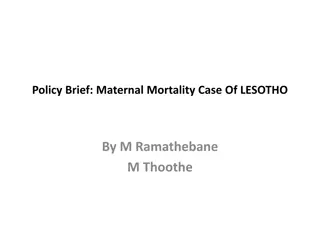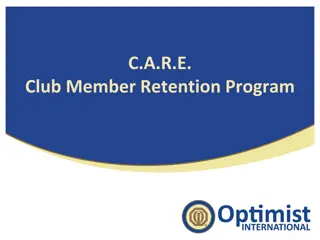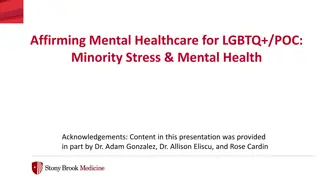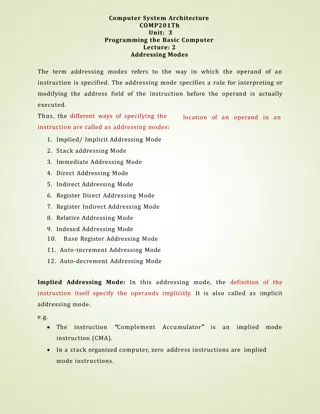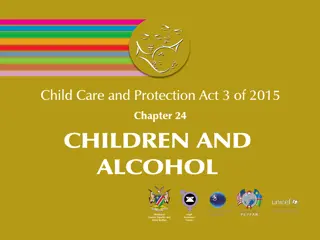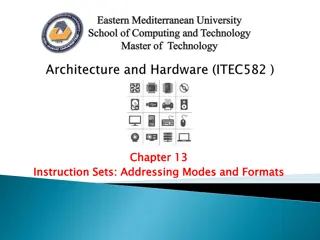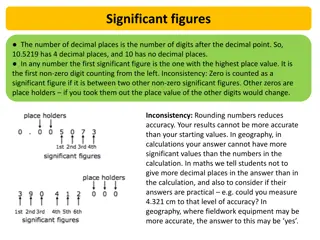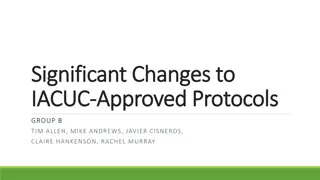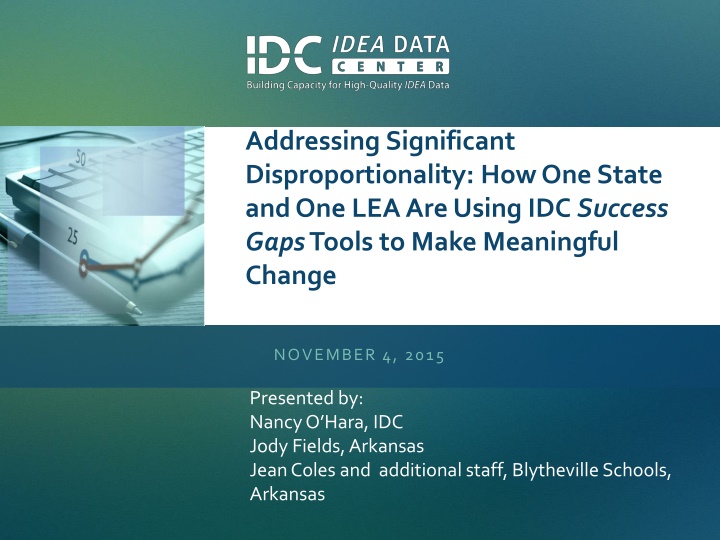
Effective Strategies for Addressing Educational Success Gaps
Learn how a state and a LEA are utilizing IDC Success Gaps Tools to tackle significant disproportionality in education. Discover the process, tools, and initiatives aimed at promoting equity, inclusion, and opportunity, ultimately bridging success gaps for all students.
Download Presentation

Please find below an Image/Link to download the presentation.
The content on the website is provided AS IS for your information and personal use only. It may not be sold, licensed, or shared on other websites without obtaining consent from the author. If you encounter any issues during the download, it is possible that the publisher has removed the file from their server.
You are allowed to download the files provided on this website for personal or commercial use, subject to the condition that they are used lawfully. All files are the property of their respective owners.
The content on the website is provided AS IS for your information and personal use only. It may not be sold, licensed, or shared on other websites without obtaining consent from the author.
E N D
Presentation Transcript
Addressing Significant Disproportionality: How One State and One LEAAre Using IDC Success GapsTools to Make Meaningful Change NOVEMBER 4, 2015 Presented by: Nancy O Hara, IDC Jody Fields, Arkansas Jean Coles and additional staff, Blytheville Schools, Arkansas
Todays Agenda Information about the Success Gaps tools: Nancy O Hara The Arkansas process for significant disproportionality: Jody Fields The story of Blytheville School District, Arkansas: Jean Coles and other Blytheville staff
Equity, Inclusion and Opportunity: Addressing Success Gaps https://ideadata.org/resource-library/54611b49140ba0d8358b4569/
What is a success gap? Differences or gaps in a variety of educational factors and outcomes that affect the likelihood of educational success for some groups of students compared to their peers Achievement Identification and/or placement for special education Suspension rates College and career preparation Graduation rates
Why Equity, Inclusion and Opportunity: Addressing Success Gaps? All states/districts/schools have subgroups of students who do not achieve as well as others Success Gaps tools present a process for identifying where the gaps are and why they are occurring. Then a plan may be created to address the root causes of the success gaps.
Structure of the Document(s) White paper: Introductory research brief Self-assessment rubric with 5 focus areas 1. Data-Based Decision Making 2. Cultural Responsiveness 3. Core Instructional Program 4. Assessment 5. Evidence-Based Interventions and Supports
Data-Based Decision Making Use disaggregated data for decisions about Curriculum and instructional programs Academic and behavioral supports Are policies and procedures effective? Make decisions about student interventions using multiple data sources, including Screening Progress monitoring Formative and summative evaluation data
Cultural Responsiveness Recognize diversity across student ethnicity, language, and socio- economic status Provide training and resources so teachers can meet the linguistic needs of all students Include parents from all backgrounds in discussions about the school and about their children s progress
Core Instructional Program Rigorous, consistent, and well- articulated K-12 instructional program, aligned with standards, delivered with fidelity Effective differentiation in the core curriculum Universal design for learning Informing parents in their native or home language about differentiation
Assessment Valid universal screening Progress monitoring for all students Informing parents in their native or home language about results
Evidence-Based Interventions and Supports Implemented with fidelity Instructional Behavioral Such as Positive Behavioral Supports or Restorative Justice Tiered response protocols, not zero tolerance Informing parents in their native or home language about interventions and responses
To address success gaps look closely at equity, inclusion, and opportunity for children in the affected groups
Rubric Organization Rubric rating scale Content Area Probing Questions Indicator Text box to describe evidence to support rating of the team
How to Address Success Gaps 1. Form a team 2. Study the data 3. Conduct a self-assessment 4. Provide evidence 5. Consider the students first 6. Ensure equitable participation 7. Develop a plan of action
What are the results of success gaps? Poor long-term outcomes for entire groups of students
Arkansas Process for Significant Disproportionality Jody Fields, PhD Director, IDEA Data & Research Special Education Data Manager
Where it begins? Identification of districts is made using risk ratios; significant differences; and requires a three year pattern. If a district meets the threshold in year four they are removed from significant disproportionality. The three year pattern will start over if the district is identified in a single year.
Notification Process Letters are sent to districts Area of disproportionality including the data A link to their Disproportionality/CEIS District Profile Required documents for submission by deadline Self-assessment (link to document online) CEIS Plan
2014/15 3 districts identified Black ID White OHI Black Discipline Special One-Day Workshop: Success Gap Rubric All three districts brought teams Started the rubric at workshop and then completed it back in district Had to submit Rubric to SEA for review. Had the option to modify CEIS plan and resubmit
2015/16 2 districts identified Black Discipline Black SLD The Rubric as introduced to all districts during the Data Summit in June 2015. Rubric is posted online for all districts to use optional
Upcoming Changes Spring 2016 Disproportionality Workshop Districts identified for review of policies, procedures, and practices Ins and Outs of disproportionality (APR vs CEIS) Success Gap Rubric And more . 2016/17: Visits to districts prior to reaching three years Onsite visits to districts with a 2 or more years of identification. Includes all disproportionality areas including 4A of APR
Blytheville School District I am pleased to present Ms. Jean Cole, Special Education Supervisor at the Blytheville School District. Ms. Cole is here to share with us Blytheville s story. Ms. Cole has embraced the use of the Success Gap Rubric across her district. Utilizing it not only a the district level, but at the building level as well.
Not So Easy Equity, inclusion and opportunity for all students is an important goal, but one that is not easily achieved. (EIO)
Questions/Discussion What questions do you have for the presenters? What thoughts do you have about using any of the Success Gaps materials?
Support is available The IDC Disproportionality and Equity Workgroup can support a state s desire to implement activities with Success Gaps. Materials are on the IDC website in the resource library: www.ideadata.org; search for success gaps . Toolbox is coming.
Contact your IDC state liaison or the IDC equity team: Julie Bollmer, co-lead, juliebollmer@westat.com Tom Munk, co-lead, tommunk@westate.com Nancy O Hara, nancy.ohara@uky.edu Cesar D Agord, cdagord@wested.org Kristin Reedy, kreedy@wested.org Terry Long, terry.long@sped-data.com
For More Information Visit the IDC website http://ideadata.org/ Follow us on Twitter https://twitter.com/ideadatacenter
The contents of this presentation were developed under a grant from the U.S. Department of Education, #H373Y130002. However, the contents do not necessarily represent the policy of the Department of Education, and you should not assume endorsement by the Federal Government. Project Officers: Richelle Davis and Meredith Miceli Project Officers: Richelle Davis and Meredith Miceli



